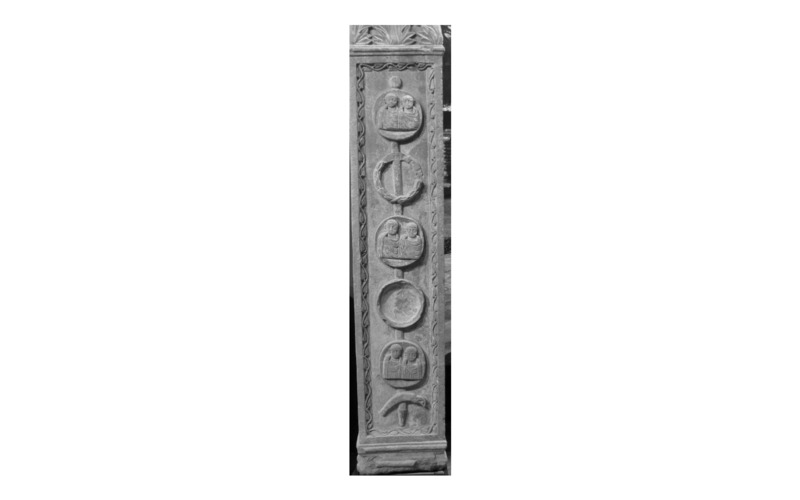Pilaster decorated with a standard bearing imperial portraits
Item
- Object Title
- Pilaster decorated with a standard bearing imperial portraits
- Spatial Coverage
- Site: Felix Romuliana/Gamzigrad
- Modern Country: RS
- Roman Province: Dacia Ripensis
- Identifier
- Pleiades ID# and Canonical URI
- Source
- Findspot Description: Western gate, associated with newer fortification walls
- Medium
- figural sculpture
- Material
- local stone
- Description
- Object Description: This rectanular pilaster preserves decoration on three sides (one wide face and the two narrow sides). The front face is divided into a narrow upper section decorated with a vegetal (stylized acanthus?) pattern. Below, the much larger middle section. This section is outined by a running vine (ivy?) marking all four side of a rectangular field. Centered within the vegetal frame is a representation of a military standard featuring five circular fieldspositioned along a vertical pole with a round finial at top and crescent-shaped bird-like representation at bottom. the pole terminates in what appears to be some sort of tapered end-cap. The top, central, and bottom roundels contin representations of a pair of male figures. In each case, the left-most figure is depicted as slightly taller than his companion. The figures contained in the middle and upper roundels are depicted as wearing a military cloak, while the figures in the lower roudel wear a toga. Placed between the upper and middle figural roundels, the circular element is likely a wreath, while the round element between the middle and lower figural roundels is a shallow dish-like shape.
- Production Marks: N/A
- Iconography: The figures in the two upper-most roundels are thought to represent the Tetrarchic emperors of the second Tetrarchy (Galerius, Maximinus Daia, Severus II, Constantius I [Chlorus]), while the lower roundel reprsents the retired emperors Diocletian and Maximian. This identification is based off of the clothing of the figures--military cloaks in the upper two roundels and togas in the lower roundel. See (--- sources) for contention that Diocletian gave up the imperial office and returned to civilian life (siginified here, it is argued, by the toga). It is this identification that is the justification for the precise chonological date assigned to this piece, and by extention, to the entirety of the newer fortification wall surrounding the site.
- Date
- 305-306 CE
- Patron
- presumed imperial
- Subject
- Keywords: military; standard; tetrarchs; abdication; ivy; acanthus; insignia
- Honorand: imperial
- Scribe
- AHC
- Entered
- 4/17/18

